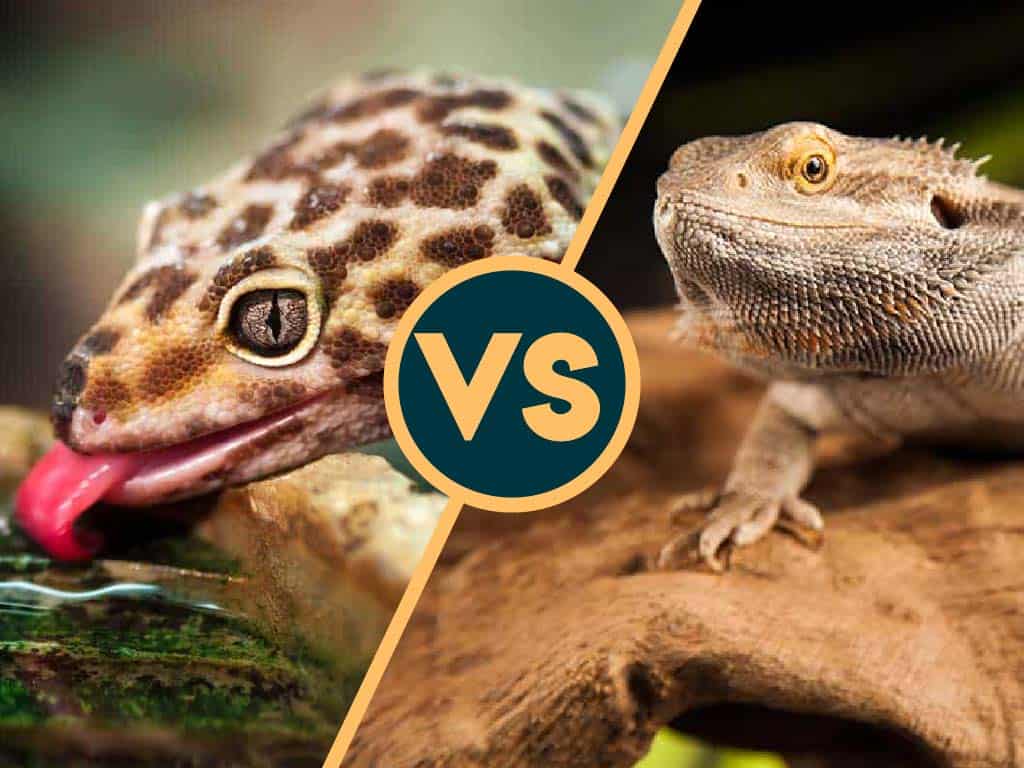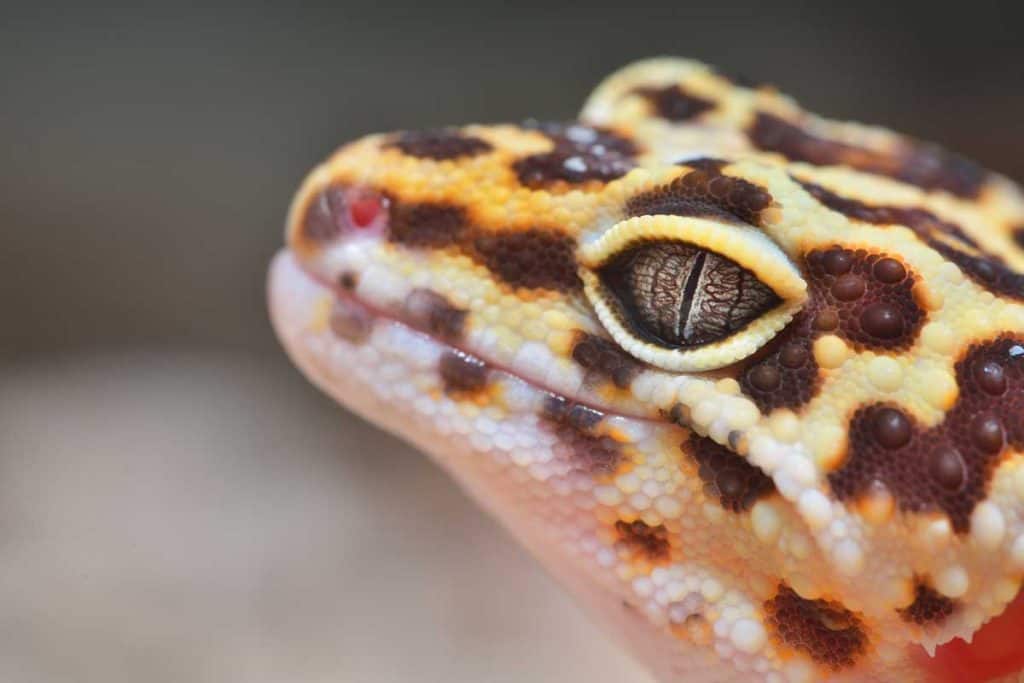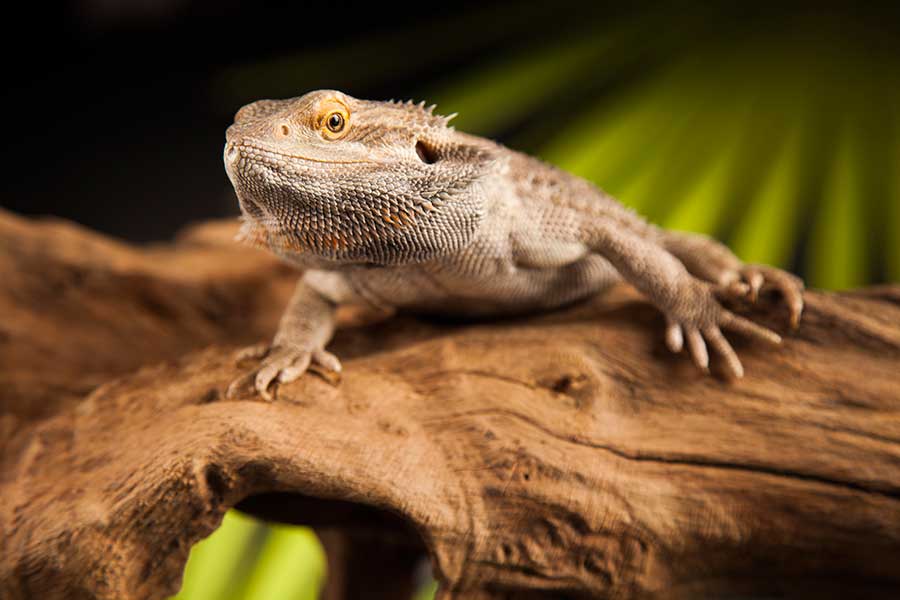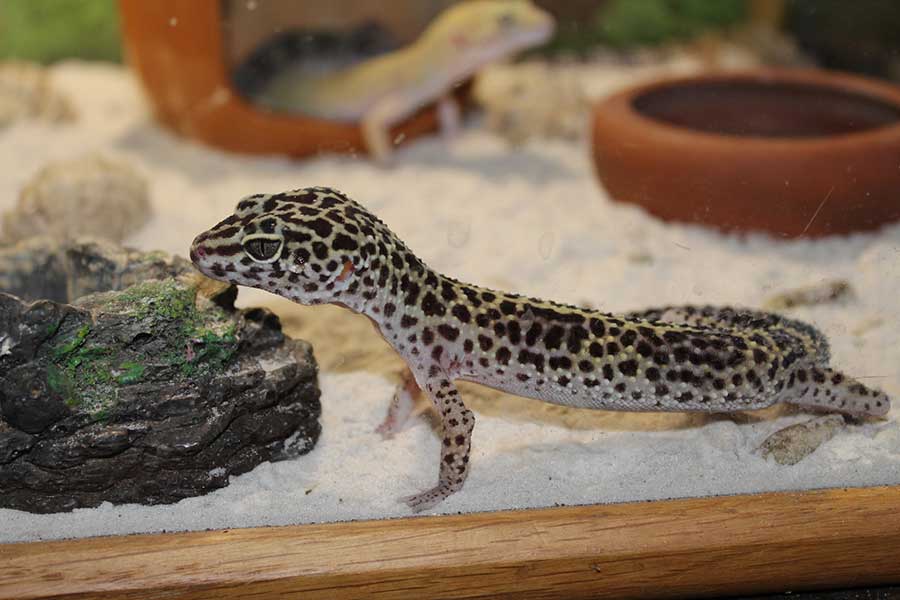Leopard geckos vs bearded dragons–which is the right lizard for you?
Leopard geckos and bearded dragons are both good choices for first time reptile owners as their care needs are relatively simple, they have great personalities, and they love being handled.
However, how do you know which one is the right lizard for you? Well, you need to have a look at the main differences between these two scaly beastie besties and decide which will fit in best with your lifestyle.
Read on to learn what those differences are and decide which is the right lizard for you!
Main Differences Between Leopard Geckos vs Bearded Dragons
The main differences between leopard geckos and bearded dragons are:
- Bearded dragons need a large enclosure, whereas leopard geckos can be housed in smaller enclosures.
- Leopard geckos can drop their tails if they are startled or scared, whereas bearded dragons do not drop their tails.
- Leopard geckos are strict insectivores, whereas bearded dragons are omnivores.
- Bearded dragons are diurnal, whereas leopard geckos are crepuscular.
- Leopard geckos have a more variable lifespan of 8 to 20 years, whereas bearded dragons tend to live for 12 to 15 years at most.
Both leopard geckos as well as bearded dragons make excellent pets for beginners. However, these key differences between the two lizards mean they are each suited to different types of owners.
Leopard geckos are suited to owners who want a small animal they can handle that also does not require a large enclosure or an expensive set up.
Bearded dragons, on the other hand, are better suited to owners who have more room for a larger enclosure and do not want a lizard that can drop its tail.
Leopard Geckos vs Bearded Dragons: Overview
Leopard geckos are small lizards that love a good cuddle as much as a juicy worm. Leos are terrestrial lizards, which means they live on the ground. They do not have pads on their toes as other arboreal geckos do; instead, they have little claws on each toe that help them run across the ground and grab onto branches and rocks.
Bearded dragons, however, are medium sized lizards and are quite a bit larger than leopard geckos. Beardies love a good cuddle and will happily sit on your shoulder for a couple of hours while you work or binge your favorite show. These are also terrestrial lizards, but they need a lot more space than leopard geckos in their enclosures.
Ideal Enclosure Size of a Leopard Gecko vs Bearded Dragon’s
An enclosure is simply a safe, enclosed environment for you to keep your lizard in. Terrestrial lizards need enclosures that are longer and wider than they are tall. This is because terrestrial animals need more floor space rather than climbing space.
Enclosures should mimic an animal’s natural habitat as closely as possible. Sometimes enclosures are small and fairly easy to keep warm and well-lit, while larger enclosures need slightly larger and more expensive equipment to maintain.
Leopard Gecko
A typical leopard gecko grows to between 8 and 11 inches in length. They are also quite chubby for their size and can weigh between 60 and 90 grams. Their small size means they don’t need very large enclosures, which makes them great inexpensive beginner lizards.
Check out our guide on leopard gecko growth rate, what you can do to enhance their growth, and what factors can inhibit their growth.
An adult leopard gecko’s enclosure should be a minimum of 20 gallons. However, leos would benefit greatly from an enclosure that is slightly larger than this at 30 to 40 gallons. Leopard geckos do not climb trees, but they do need and definitely appreciate some rocks or branches to crawl over and explore.
You can also check out our guide on leopard gecko enclosures to see which we prefer the most.
Bearded Dragon
Bearded dragons grow to between 20 and 24 inches. They are quite a bit larger than leopard geckos, and the typical beardie’s weight averages out at around 400 grams. This means they need large enclosures to accommodate their size. Bearded dragons are also more active than leopard geckos, which means they need the extra space to move around.
Check out our guide on bearded dragon growth rates.
An adult bearded dragon’s enclosure should be a minimum of 40 gallons. However, this is the absolute minimum size for an adult, and they would benefit far more from being kept in a 60+ gallon enclosure. The enclosure needs to have a lot of floor space for running around, as beardies often get the zoomies!
Check out our guide on the best bearded dragon enclosure set up.
Advantage
There is no clear winner when it comes to enclosure size, as this will depend on what space you have available in your home to devote to your lizard’s new home.
If you have the space for a 60-gallon enclosure and can outfit it with all the bits and bobs it needs, then a bearded dragon is best. However, if you only have a small amount of space for an enclosure, then a leopard gecko is the one for you!
Tail Dropping
Tail dropping is scientifically known as autotomy. Tail dropping is used as a defense mechanism by many different kinds of lizards. In the wild, if a lizard is attacked by a predator such as a bird or a cat, they can quickly sever their own tail and make an escape.
This is done both to distract the predator with a tasty treat and to allow the lizard to run away to safety. Some lizards can regrow their tails multiple times, while others cannot. Most lizards’ tails are mainly used to store fat and other nutrients.
Leopard Gecko
Leopard geckos can and do drop their tails. They are fairly hardy and are not as easily spooked into dropping their tails as crested or Tokay geckos are. However, they will still drop their tails occasionally if they are handled roughly or get a fright.
Luckily, leos are one of the types of lizards that can regrow their tail fairly quickly. A regrown tail will not have the same patterns as the old one, and it will usually be slightly shorter and/or a different shape.
However, there are no serious health concerns if your leo drops its tail. You do need to ensure that you increase the amount of food they get as well as their
Bearded Dragon
Bearded dragons are not able to drop their tails as leopard geckos do. This means you do not need to worry about a body part falling off if you handle them a bit too roughly. This also makes them a better candidate for regular handling.
Instead of dropping their tails, bearded dragons are more likely to bite and scratch you because they do not have an escape plan if they are attacked by a predator or feel threatened.
It’s a Coin Toss
When a leopard gecko drops its tail, no harm is done to it, and it can regrow within a couple of weeks. However, bearded dragons do not drop their tails at all. On the other hand, bearded dragons are more likely to bite you than leopard geckos are because they do not have this defense mechanism.
This comes down to personal preference whether you want a lizard that drops its tail or not.
Diet
A lizard’s diet is made up of everything that it eats. This includes the nutritious staple items as well as the occasional treat items you offer your lizard.
Lizards can be herbivorous, omnivorous, or insectivorous. What type of diet they have will determine what they can and cannot eat. This will also affect how expensive the animal is to feed.
Leopard Gecko
Leopard geckos are insectivores. This means they only eat insects. Their digestive systems are not built to handle fruits, vegetables, or greens. If they are fed these things, they will get very sick. Fortunately, there are many different nutritious and inexpensive insects you can feed your gecko.
Staple insects to include in your leopard gecko’s diet are:
- Crickets
- Dubia roaches
- Phoenix worms (also known as NutriGrubs or black soldier fly larvae)
- Silkworms
- Hornworms
As for treats, you can also offer your leopard gecko fattier insects like waxworms and butterworms.
It is best to feed your little leo live food because this enriches them mentally and physically and also makes feeding time more natural for them.
Check out our guide on what to feed your leopard gecko.
Bearded Dragon
Bearded dragons are omnivores. This means they eat insects as well as a mixture of vegetables and a small amount of fruits.
When a bearded dragon is a baby, their diet needs to be roughly 80% insects and 20% plant material. However, when they reach full maturity, this ratio is reversed, and their diets are made up of 20% insects and 80% plant material. Most of the plant matter they consume should be made up of dark greens and a small amount of other veggies and fruit.
This ratio changes over time because when bearded dragons are younger, they need a lot of protein (from insects) in order to grow and develop healthy muscles, bones, and organs. However, as they become older, they do not need as much protein, since they are growing much more slowly (or not at all if they’ve reached their full size).
Bearded dragons can eat the same insects that leopard geckos can as well as the slightly larger and more chitinous superworms and mealworms. Check out our guide on the top feeder bugs for bearded dragons.
Safe and nutritious salad items for bearded dragons include:
- Mustard greens
- Dandelion greens
- Yellow and orange squash
- Blueberries
- Strawberries
- Banana
- Honeydew melon
- Zucchini blossoms
Something to Digest
This will also come down to personal preference. Do you want to prepare salad items as well as insects, or do you want to focus on only feeding your lizard insects?
Although bearded dragons are slightly more expensive to feed than leopard geckos, they are also less time-consuming. This is because lizards should always be observed while they eat insects so none of the bugs escape or end up left behind in the enclosure.
If you want to add salad into the mix and don’t mind spending a bit more on plant material, then the bearded dragon wins. However, if you want to focus on insects and maybe even start your own insect farm, then the leopard gecko is for you!
Active Hours
Lizards are active during different hours depending on whether they are diurnal (day-dwelling), crepuscular (dawn and dusk dwelling), or nocturnal (night-dwelling).
Leopard Gecko
Leopard geckos are crepuscular lizards. This means they are most active during the hours of dawn and dusk. They will also sometimes be active at other times during the day; however, dawn and dusk are the times when the magic happens.
If your gecko’s enclosure is in a room that receives little light, then they may be active during daylight hours too.
Keep in mind they will need to be fed during these hours to allow them the maximum time to digest their food while they are moving around.
Bearded Dragon
Bearded dragons are diurnal. This means they, like humans, are most active during the daylight hours. Because they are day-dwelling lizards, they need to have a good lighting setup that includes heating and UVB lighting that mimics the sun’s rays.
Check out our guide on the top UVB bulbs to have in your bearded dragon’s enclosure.
Which Clicks with Your Clock?
The winning lizard here will be the one that fits into your lifestyle the best. Are you more active and around more during the day? If so, then the bearded dragon is the lizard for you. Are you more active in the mornings, evenings, and at night? In that case, the leopard gecko is the winner.
Additionally, leopard geckos’ lighting setups are generally a bit cheaper, since they don’t necessarily require UVB lighting to survive and thrive. Keep this in mind when you make your decision.
Lifespan
Some lizards, such as green anoles, have very short lifespans. However, some have very long lifespans, such as blue tongue skinks. When choosing a lizard, you need to carefully consider what kind of time commitment you are willing to make when it comes to their care.
Leopard Gecko
Leopard geckos live between 10 and 20 years. They have a very broad lifespan, and you will not be able to determine their full age when you get them as a baby.
Leopard geckos have such a broad lifespan because there are many things that can negatively affect them. A few of these factors include:
- When they drop their tails, if they do not get enough additional nutrients, they can suffer from a reduced lifespan.
- Some owners do not think that their leos need
calcium supplements because they only eat insects. However, they do need the extracalcium boost from a supplement three times a week. Without enoughcalcium , they will live a shorter life.
Bearded Dragon’s
Bearded dragons live on average 12 to 15 years. They are pretty hardy lizards, and unless they are subjected to a lot of external stressors or malnourishment, they will live to their expected age.
Long Life
A bearded dragon’s lifespan is generally more predictable than a leopard gecko’s; however, there is the chance that if proper husbandry is practiced and they have decent genetics, then your leopard gecko will outlive a bearded dragon. The overall length of these lizards’ lifespans are fairly similar.
FAQs on Beardies and Leos
Do leopard geckos or bearded dragons bite more?
Bearded dragons are known to give venom-less but nasty bites, if they are upset or startled. Leopard geckos prefer to run away from a stressful situations.
Can I keep leopard geckos and bearded dragons together in the same enclosure?
You should not keep different species of lizards in the same enclosure. Different species require very different enclosure conditions to thrive.
Which is a noisier lizard: leopard geckos or bearded dragons?
Bearded dragons can hiss and grunt when they are upset or stressed, but they are mostly silent. Leopard geckos are a bit more vocal. They will chirp and squeak when it is feeding time, and they may serenade you with little barks and chirps in the middle of the night for fun.
Bearded Dragon vs Leopard Gecko Wrap-Up
To wrap things up, let’s go over the differences between these lizards one more time so you can select which one best suits your lifestyle and preferences.
Adult leopard geckos can live in enclosures that are 20 to 40 gallons in size. However, bearded dragons are quite a bit larger than leopard geckos, so they need to live in an enclosure that is at least 40 gallons but preferably 60+ gallons in size.
In addition, bearded dragons are better suited to owners who can provide them with enough space to live comfortably. Therefore, if you do not have the space for a 60-gallon enclosure, the leopard gecko wins.
Leopard geckos do drop their tails when they are startled or scared. However, their tails grow back pretty quickly, and even though the new tail will not look quite the same, autotomy does not do any kind of permanent damage to your leopard gecko. On the other hand, bearded dragons are not able to drop their tails.
Both leopard geckos and bearded dragons eat insects. However, bearded dragons also eat salads made up of fruit, greens, vegetables, and flowers. Generally, the easier of the two lizards to feed would be the leopard gecko because you do not need to prepare two different kinds of food for it.
Also, leopard geckos are active during dawn, dusk, and nighttime hours in general. If you are a night owl and will be awake to enjoy your lizard during this time, then the little leo wins. However, if you want to interact with your lizard during the day, then the bearded dragon is likely best for you!
Finally, bearded dragons have a more definitive lifespan of 12 to 15 years. They are hardy animals that predictably live to this age range. Leopard geckos, on the other hand, have a very wide age range for their lifespan. Bearded dragons win if you want predictability. However, leos win if you want a lizard that could possibly live to 20 years old!
Final Word
Leopard geckos and bearded dragons are both fantastic beginner pets because they are easy to take care of and have great personalities.
Neither of these lizards is necessarily better than the other, but each is suited to different owners’ lifestyles. You can choose which lizard fits into your lifestyle the best by examining the main differences between leopard geckos and bearded dragons.





